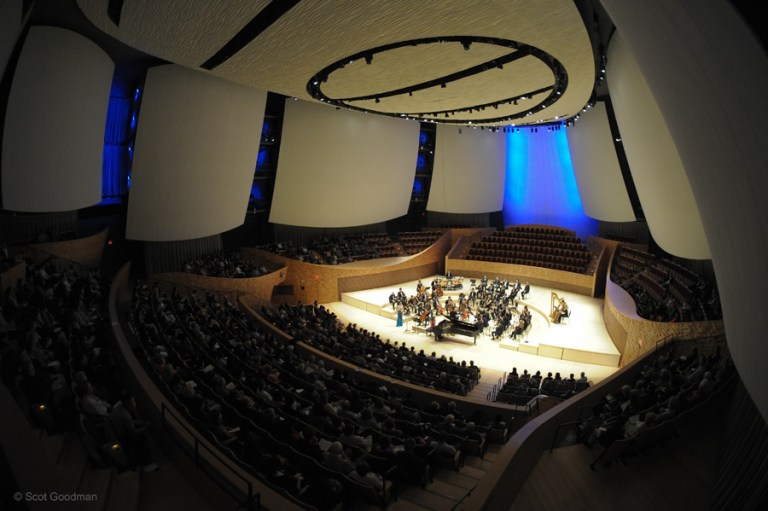A week ago, I had the pleasure of attending the Stanford Philharmonia concert at Stanford’s very own Bing Concert Hall. Conducted by Anna Wittstruck, the performance featured various works by French and Spanish composers. After opening with Claude Debussy’s classic “Prélude à l’après-midi d’un faune” (Prelude to the Afternoon of the Faun), the concert featured the world premier of José González Granero’s “Concerto da Camera.” Maurice Ravel’s “Pavane pour une infante défunte” (“Pavane for a dead princess) followed. The concert concluded with “Les nuits d’été” (“Summer Nights”) by Hector Berlioz.
“Prélude à l’après-midi d’un faune” has been a favorite of mine for years. Based on an erotic work by Symbolist poet Stéphane Mallarmé that tells the story of a faun who dreams of various sexual encounters, this impressionist piece captures the atmosphere of this dream-like state. Often considered one of the first pieces of modern music, this piece is constantly changing and merging with various melodies and harmonies, a fluid and mysterious piece.
Opening with a fantastic flute solo, the Philharmonia delivered a wonderful rendition of this Debussy Piece. Masterfully capturing the flowing harmonies and the periodical tension, the orchestra was able to add their own touch to this iconic piece.
In contrast to this iconic opener, the second piece was the world premiere of José González Granero’s “Concerto da Camera.” This piece featured members of the Ensemble San Francisco: Rebecca Jackson on violin, Jonah Kim on cello and Christine McLeavey on piano. Going into the concert, I had absolutely no idea what to expect from this piece. Perhaps that was for the best, because I was delightfully surprised by its raw intensity. In an unusual move, this piece consists of only two movements: an adagio and an allegro. The opening movement, a downbeat adagio, featured haunting and lyrical melodies that seem to permeate the entire concert hall. The second movement, a brisk allegro, was very rhythmic and featured blaring brass hovering over it all at times.
However, this energetic piece cannot be described by music alone. The performers (especially the three featured artists) swayed and moved to the music, adding to the intensity of the atmosphere. The combination of this dynamic piece with the visual aspects added by the performers gave me goosebumps and shivers down my back. The experience was an unforgettable one, not only for me but likely for many other audience members, seeing as the pieced was followed by a standing ovation.
After a brief intermission, the concert resumed with Ravel’s “Pavane pour une infante defunte.” Despite the title that seems to imply mourning, this piece is hopeful. Instead of being a mournful melody for the death of a princess, it instead tries to capture the hopefulness of a dance that the late princess may have danced. Filled with flowing melodies, this piece featured solo horn and harp. The orchestra perfectly expressed the hopefulness of this impressionist piece. With the expressive string and woodwind lines, the piece resonated with a bittersweet sadness.
For the finale, the Philharmonia performed an engaging rendition of Hector Berlioz’s “Les nuits d’été,” a series of five songs with lyrics by Théophile Gautier. The first song, “Villanelle,” recounts the journey of two lovers through a forest. The second, “Le spectre de la rose,” has a rose telling its tale of being killed to be worn upon a bosom. Taking a turn into darker territory, the next song “Sur les lagunes” is a lamentation mourning the loss of a loved one. The themes of loss and lamentation permeate the next two songs (“Absence” and “Au cimetière”) until a slightly hopeful change occurs in the final song, when a woman asks to explore the shores of the unknown world. Experiencing the twists and turns of these songs was certainly an unforgettable experience, thanks to the Stanford Philharmonia and the fantastic singer Kindra Scharich. Scharich, a mezzo-soprano, was masterfully able to express the themes and stories of the five songs to an audience that, for the most part, was unable to understand a single word of them.
This concert provided a brief yet extremely engaging window into the music of French and Spanish impressionist composers as well as a taste of modern composition. It was an appetizer to a far larger world, an exposition of a tiny yet important corner of music history. If the intent of this concert was to foster interest and to get others to seek out similar music, it succeeded wonderfully. I look forward to attending Stanford Philharmonia concerts in the future, and I suggest that any who can attend as well to do so for a window into a musical culture both different and strikingly similar to our very own today.
Contact Benjamin Maldonado at [email protected]
